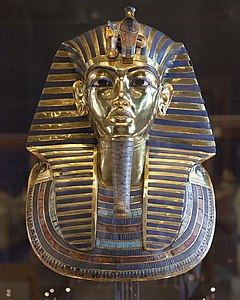
Tutankhamun
Monarch
Who is Tutankhamun?
Tutankhamun was an Egyptian pharaoh of the 18th dynasty, during the period of Egyptian history known as the New Kingdom. He is popularly referred to as King Tut. His original name, Tutankhaten, means "Living Image of Aten", while Tutankhamun means "Living Image of Amun". In hieroglyphs, the name Tutankhamun was typically written Amen-tut-ankh, because of a scribal custom that placed a divine name at the beginning of a phrase to show appropriate reverence. He is possibly also the Nibhurrereya of the Amarna letters, and likely the 18th dynasty king Rathotis who, according to Manetho, an ancient historian, had reigned for nine years—a figure that conforms with Flavius Josephus's version of Manetho's Epitome.
The 1922 discovery by Howard Carter and George Herbert, 5th Earl of Carnarvon of Tutankhamun's nearly intact tomb received worldwide press coverage. It sparked a renewed public interest in ancient Egypt, for which Tutankhamun's burial mask, now in Cairo Museum, remains the popular symbol. Exhibits of artifacts from his tomb have toured the world. In February 2010, the results of DNA tests confirmed that he was the son of Akhenaten and Akhenaten's sister and wife, whose name is unknown but whose remains are positively identified as "The Younger Lady" mummy found in KV35.
We need you!
Help us build the largest biographies collection on the web!
- Also known as
- King Tut
- Tutankhaten
- Nebkheperura Tutankhamun
- Tutankhamen
- Tut-Ankh-Amen
- Parents
- Siblings
- Spouses
- Ankhesenamun
(-1332 - -1322)
- Ankhesenamun
- Nationality
- Egypt
Submitted
on July 23, 2013
Citation
Use the citation below to add to a bibliography:
Style:MLAChicagoAPA
"Tutankhamun." Biographies.net. STANDS4 LLC, 2024. Web. 25 Apr. 2024. <https://www.biographies.net/people/en/tutankhamun>.

Discuss this Tutankhamun biography with the community:
Report Comment
We're doing our best to make sure our content is useful, accurate and safe.
If by any chance you spot an inappropriate comment while navigating through our website please use this form to let us know, and we'll take care of it shortly.
Attachment
You need to be logged in to favorite.
Log In